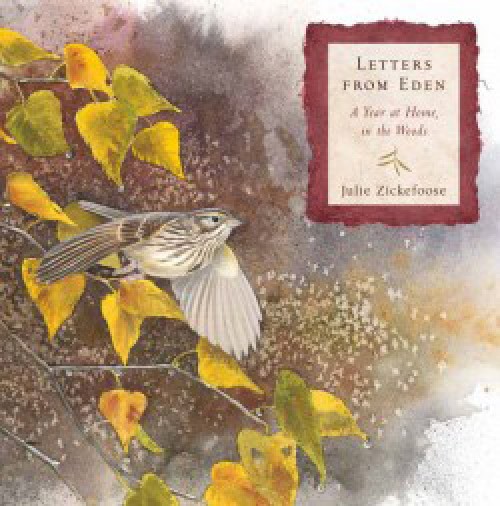by By Julie Zickefoose
Houghton Mifflin, 2006
Through the 31 essays that make up Letters from Eden: A Year at Home, in the Woods, author Julie Zickefoose demonstrates how truly at home she is on the 80 acres of forests and fields where she lives.
The book’s title reflects the progression of the seasons, not the gestation period for this book. Indeed, Zickefoose spent about eight years creating the essays, field notes, pencil drawings, and watercolors for this gem. She also shares what she’s learned during decades of dedicated observation, including her years as a field biologist for The Nature Conservancy spent establishing a program to protect piping plovers along the Connecticut shoreline.
In the introduction, New Hampshire’s Sy Montgomery states: “Julie knows where and how to find the dramas that unfold all around us – right here in the real world, the natural world that was our first and, still, our proper home. … ”
Zickefoose has settled in the Appalachian foothills of southeastern Ohio, and she describes what she’s discovered during walks on her land. Few of her encounters are conventional. When she finds a dead possum, she suspects it was killed by a great horned owl, not a coyote. A coyote would have the strength to carry and cache its prey. The next day, eager to solve the whodunit, Zickefoose hurries to find the carcass. It’s gone. In its place, she finds two large, yellowish white splats confirming the presence of a great horned owl. Zickefoose muses: “I realize I am laughing and talking to myself, and I have to laugh again at the thought of a woman moved to rapture by half a possum and two owl droppings.” On a walk along the trail the following day, Zickefoose and her husband see a large owl. “Buffy-fawn below, its wings laced with the same color, it can only be a great horned, the first one we’ve sighted on our land. Not all my wildwood sleuthing ties up so nicely,” she writes.
For better or worse, Zickefoose interacts with life in her backyard Eden. For instance, friends bestowed several second-year bullfrog tadpoles (the species spends two years in “tad” stage) to enliven the 200-gallon pondlet in her water garden. Fourteen months later, Zickefoose discovers that the largest, a male she’s named Fergus, has downed a hummingbird. A few weeks later, when she sees that Fergus is gulping a chipping sparrow (he’s a big, brawny bugger), that’s it. Zickefoose grabs Fergus – the sparrow’s tail feathers sticking out of his mouth – runs into the house, plops him in a big jar, and plans his future.
Zickefoose asks, “Why am I so furious with Fergus? Why do I feel so betrayed? Fergus is just being a frog. … Bullfrogs, I have come to learn, eat birds. Bullfrogs, in fact, eat anything they can cram in their mouths.”
Letters from Eden is more than a collection of essays. From nearly every page springs one of her pencil or watercolor sketches of a bird, mammal, reptile, or plant. Pencil sketches pulse with the freshness of a field study. Notes, jotted on many of these sketches, add immediacy and credibility to her works. Sprinkled through the book are portraits of robins, box turtles, phoebes, bullfrogs, copperheads. Reminiscent of Louis Agassiz Fuertes’s watercolors of animals a century ago, these portraits are rich in detail. Many are laden with attitude.
With this charming collection, those familiar with Zickefoose’s illustrations and columns for Bird Watcher’s Digest will feel they’ve happened on the mother lode. National Public Radio listeners who’ve heard Zickefoose’s commentaries on “All Things Considered” are in store for a twin treat: crisp, lyrical prose paired with art.


